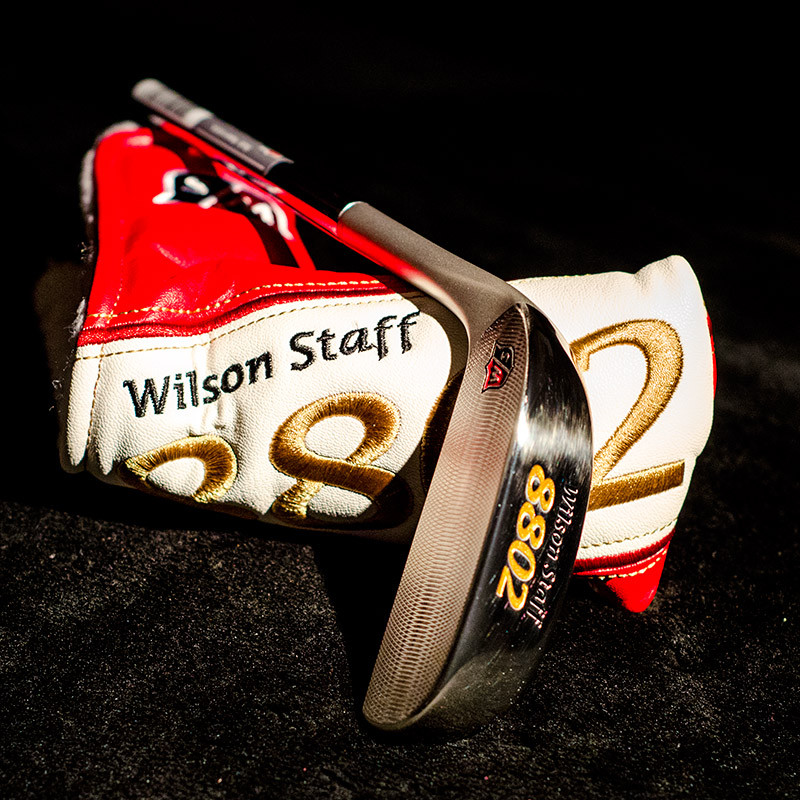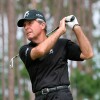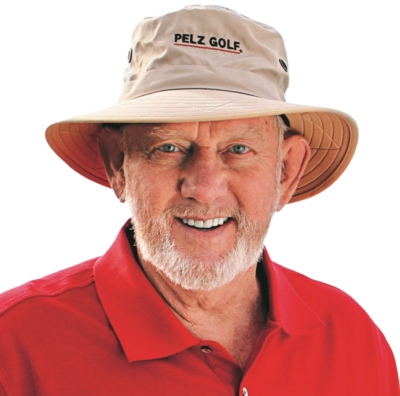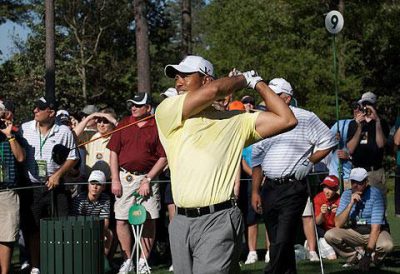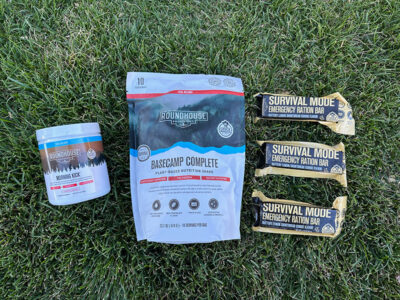Wilson 8802 Putter Review
Categories: Golf Clubs • Golf Equipment • Golf For Women • Golf Gear • Reviews
Tags: Arnold Palmer • Ben Crenshaw • Greg Norman • Phil Mickelson • putter • putters • Wilson Golf
(In the voice of Tom Hanks) Wiiilllson!!!
The Wilson 8802 putter has been at the center of numerous major championships and great victories on many professional tours. The 8802 design has been seen in use by the likes of Arnold Palmer, Ben Crenshaw, Greg Norman, and Phil Mickelson. The Wilson 8802 is one of the all-time greats. It has stood the test of time and today is still a great putting choice. Let’s take a look at the Wilson 8802 putter.
Design
The 8802 is a heel-shafted blade putter. In english, the shaft is attached to the end of a thin putter head. This is perhaps one of the most popular designs in the history of putters. There’s a reason it is so popular, it works.
The head is milled from 304 stainless steel, a fairly soft metal. The softness produces great feel and feedback for the player, and helps the player control distance.
To perform well on modern greens and modern green speeds, the head weighs in at 335 grams.
The face of the 8802 features some precise milling patterns which are designed to produce a true and straight roll. See photo below:
Looks
Standing over this putter the player is not distracted by busy and complex designs, nutty shapes, or fancy graphic art. The look is as clean as clean could be.
The slightly matted silver finish is easy on the eyes and does not produce annoying glare which more shiny putters can produce on sunny days.
Feel
The soft 304 metal helps the putter produce a nice feel, which gives the player great feedback. Off-center putts still roll well and true, but the putter’s feedback will let the player know the shot was not on the center of the face. Center-face putts are butter.
On The Course
I’m normally a heel-toe weighted, center-shafted or center-axis-shafted putter player. So I figured the balance and weighting of this blade putter would be problematic for me. Not the case. Somehow, despite being a heel-shafted blade, the balance of the putter is fantastic. I never had an issue with keeping the face square at impact.
The face milling helps roll the ball pure and right on line. There were never any surprises with regards to the roll or the line.
Critiques
In its simplicity, there’s no alignment line on the top of the putter to indicate the sweet spot and line up the ball. There’s an element of doubt when I line up as I’m not 100% sure I’m lined up on the right spot.
The putter is only available in 35″ versions, right handed. Sorry lefties or short people! I’m not tall and I have long arms, so 34″ putters or even shorter is good for me. Because the 8802 is 35 inches I have to choke down quite a bit to perform my natural stroke.
Head Cover
One of my pet peeves is head covers. At least 18 times per golf round the player will interact with the putter cover. The last thing I want is a crappy cover which does not protect the most important stick in my bag. Even worse is when that cover is hard to use.
The included head cover for the Wilson Golf 8802 Putter is very sharp looking and does its job well. The putter is well padded and protected from dings. The soft metal in the putter makes it even more susceptible to such dings and dents from other clubs in the bag.
The cover seals via Velcro, which I’m not a big fan of. Velcro wears out over time. A better solution would be a magnetic seal. Even better would be a design which uses no magnets or Velcro.
Conclusion
The reasonably priced $179 Wilson Staff 8802 Putter is the most expensive putter in Wilson Golf’s lineup and for good reason. It is a fantastic putter with great feel and performance. The 8802 design is a proven winner through decades of victories by some of the world’s greatest putters.
State of the Game: Golf Through Arnie’s Eyes
Categories: (British) Open Championship • Champions Tour • Miscellaneous • PGA Championship • PGA Tour • Pro Golf
Tags: Arnold Palmer • Golf Channel
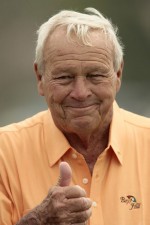 Through Golf Channel, the King Arnold Palmer has published his 2013 State of the game:
Through Golf Channel, the King Arnold Palmer has published his 2013 State of the game:
STATE OF THE GAME: GOLF THROUGH ARNIE’S EYES
By Arnold Palmer
Published December 29, 2013
This is the season of nostalgia. As one year of memories gets packed away, another filled with opportunity beckons. Before we jump headlong into 2014, I’d like to take a few minutes and remember some of the good people we lost in 2014.
My formative experience with losing a loved one came in 1950. I was a senior at Wake Forest when my roommate, Bud Worsham, was killed in an automobile accident. Bud was my best friend; in fact, he was the reason I had attended Wake Forest in the first place. What made his loss even harder to handle was the fact that I might very well have been in that car that night had I not opted to skip a Homecoming dance and instead attend a movie.
I bring that up because there’s not a day that goes by that I don’t think of Bud Worsham. There’s not a facet of my life that hasn’t been improved for knowing him, albeit so briefly. I’ve lost many loved ones over the years: my father in 1976, my mother in 1979 and of course, my wife Winnie in 1999. But Bud’s death taught me the lesson—wrenching as it was—that death is a part of life, and that the memories are worth the pain. I celebrate that lesson in remembering these departed friends.
Miller Barber: If all you knew about Miller Barber was his golf swing, you’d say he had no shot. He had the ultimate chicken-wing right arm and held the club virtually perpendicular to the ground at the top of his backswing. But what people overlooked with Miller—as they do with most good players with unorthodox swings—was that he had a great release through the ball. And while he may not have been the most athletic looking player, Miller was very strong and very powerful.
He also enjoyed a pretty colorful nightlife, though one that was opaque to the rest of us. In those seemingly simpler days, groups of us would often get together and frequent the same bars or restaurants, but Miller never told us where he was going that night or where he’d been the night before. As a result, our PGA Tour colleague Jim Ferree dubbed Barber “The Mysterious Mr. X.” Over time the moniker was reduced simply to X. Up until the last time I saw him, I still called him X, not Miller. He had a great sense of humor and took to the nickname. But he also remained the man of mystery and a very close friend.
Bill Campbell: Bill was not only one of the great gentlemen of the game, he was one of the great gentlemen, period. Sandy Tatum, the high priest of American amateur golf, once said that “in the whole history of golf there have been just two ultimate quintessential golfers: Bill Campbell and Bobby Jones.”
Like Jones, even though he lived a full life off the course, Bill regularly competed against the best players in the world. Although he and I were never paired together in a major championship, we did compete in 1965 when Jack Nicklaus, Gary Player and I took on three outstanding amateurs in Bill, Deane Beman and Dale Morey. I wasn’t playing my best, and as we were walking down the fairway I was trying to keep a positive outlook. I said to Bill, “My father always said to me, ‘He can who thinks he can.’ Bill, do you believe you can force yourself to do things?”
Bill said, “Well, Arnold, I can’t argue with that. You’re pretty strong evidence of it.”
Perhaps the story that best illustrates Bill’s exalted place in the game came from Jack Nicklaus. Years ago Jack had been debating the finer points of amateur status with Frank Hannigan, the former executive director of the USGA. Jack said to Frank, “Name one top amateur who doesn’t take anything from the manufacturers.’
“Bill Campbell,” replied Hannigan. Jack paused for a moment. “Okay. You can have Campbell,” he said. “Name another one.”
Frank Stranahan: Stranny, who passed away in June, is one of the most overlooked talents in the history of the game. This guy was sensational. He pretty much won everything there was to win as an amateur, including three North and Souths, three Western Ams, two Canadian Ams and two British Ams. The only important amateur trophy that eluded him was the U.S. Amateur, in which he finished runner-up in 1950.
Given that he came from a wealthy family (his father founded Champion spark plugs), many of us expected Frank to remain a lifelong amateur, but he turned pro and won six times on the PGA Tour before leaving competitive golf in the mid-1960s to focus on business. “Muss”, as we also called him because of his fastidious appearance, had the complete package: a terrific game, dazzling good looks and lots of money. People credit Gary Player with bringing fitness to the game of golf, but Stranny, who used to travel with barbells in his suitcase, was a devoted fitness buff and health nut. He ran dozens of marathons, and competed in bodybuilding and weightlifting well into his 70s.
One last note about Frank. I am often given credit for “salvaging” the British Open in the early 1960s. We can argue whether or not the game’s most historic championship really was in danger of sinking, but it is safe to say that after World War II, many American competitors simply found it easy and more profitable to compete here in the United States. Frank never quit on the Open. He continued to compete there on a regular basis, and finished second in 1947 and 1953. His devotion to the Open Championship is what inspired me to go over in 1960. I won the following year, and I’ve been credited ever since with “saving” the Open, but it was Frank who paved the way.
Pat Summerall: His Fox Sports colleague John Madden put it best when he said of the millions of sports fans who embraced Pat Summerall’s mellow brand of broadcasting, “They invited a gentleman into their homes.”
Whether it was football or golf, Pat became as much a part of the fabric of American sports as the leather on the arms of our easy chairs. I thought it was a beautiful gesture when Augusta National Golf Club offered him membership upon his retirement from television. Though out of the spotlight, the final years of Pat’s life, when he reacquainted himself with the most important thing in anyone’s life, family, were some of the happiest he ever enjoyed.
Ken Venturi: Ken became well known to casual golf fans when he joined the television booth in the late 1960s, but he was a force in the game as early as the late 1940s. A student of Byron Nelson and frequent playing partner of Ben Hogan, Ken was a formidable talent whose career was both sparked and unraveled by physical ailments. He first took up golf as a 13-year-old in response to his teacher’s diagnosis of Ken as a “an incurable stammerer.” He took up the loneliest sport he knew.
His ironman performance in winning the 1964 U.S. Open while battling severe dehydration remains the hallmark by which on-course toughness is measured. But ultimately it was another physical challenge, carpal tunnel syndrome, that forced his early retirement in the late 1960s and encouraged his transition to the broadcast booth.
Ken and I will likely forever be linked by a rules decision invoked while playing in the final round of the 1958 Masters. On the 12th hole, I hit a 6-iron off the tee and my ball plugged into its own pitch mark on the back fringe of the green. The ground was wet and soft, and a local rule providing relief from an embedded ball was in effect all week. I was leading by a shot, and just to be safe I called over the rules official, the late Arthur Lacey. I proposed that I could lift, clean and drop my ball without penalty to a spot as close as possible to the original position and no nearer the hole (a stance with which Ken agreed), but Lacey disagreed, saying I had to play the embedded ball. I knew I was right, but I wasn’t in much of a position to argue. Finally, I said, “I’m going to play two balls and appeal to the tournament committee.” I knew I had that option under Rule 3-3a.
Lacey objected, saying, “No sir, you cannot do that either.” I told him, “Well, that’s exactly what I’m doing.” I played the original ball as it lay for a 5 and then announced that I was about to play a second ball. I dropped to a clean lie and made par. Ken objected, saying that I was required to announce to him that I was going to play two balls before I played the original. The officials on site at the Masters reviewed the case, agreed with me, and I won my first Masters by a shot.
That incident affected our relationship. We both wrote about it in subsequent books, each of us insisting that we were right. I think the whole episode says more about the confusion built into the Rules of Golf than it does about me or Ken. I regret that the incident affected our relationship. Ken was a remarkable human being, and a warm and true friend to thousands of people in and out of the game.
Best Wishes To Arnold Palmer
Categories: PGA Tour • Pro Golf • Tiger Woods
Tags: Arnold Palmer
At the end of the Arnold Palmer Invitational at Bay Hill I was waiting to see Arnold Palmer greet Tiger Woods as he came off the final green. That’s been a tradition, greeting the winner on the final green, for many years. But this time, there was no Arnold on the 18th.
Later it was announced in the press room that Arnold was taken to a nearby hospital due to high blood pressure. Apparently he was on some new medications which weren’t working well, causing the jump.
“Nobody is overly concerned about his prognosis. It wasn’t anything to do with any ailments or any discomfort he felt. The blood pressure was at a level where the doctor involved suggested that he go immediately to get more intensive evaluation at the hospital.” ~ Arnold Palmer’s business manager, Alastair Johnston
Arnold (82) is doing fine, and they expect him to only have one overnight stay before leaving the hospital. He needs to be well for the opening ceremony of the Masters in about 1.5 weeks!

Get well Arnie. We need you to open up the Masters!
Sending my best wishes to you Arnie… I know you are a regular reader here. Ahem. 🙂
Arnold Palmer press conference features questions about Tiger Woods, Mr. Woods, Tiger, TW and of course Tiger Woods
Categories: Boneheads • Golf Media • Miscellaneous • PGA Tour • Tiger Woods
Tags: Arnold Palmer • Bay Hill • Tiger Woods
Just listened to the Arnold Palmer presser at Bay Hill. I say “listened” because for the life of me I can’t get these live video feeds on PGATOUR.com to work. They only play audio. I’ve upgraded my Flash player a million times, and even recited Shakespear backwards in Latin with a lampshade on my head, but still no video… A rant for another day (probably tomorrow).
Arnie answers questions about Tiger Woods, Tiger Woods, Tiger, Mr. Woods, The Masters, Tiger Woods, TW, Bay Hill, Eldrick and of course Tiger Woods
You just have to love the press right? Well, no. 24/27ths of the questions they asked Arnie were about Tiger Woods. Arnie did his best to politically correctly (huh?) dance around the personal stuff to basically say that you can never count Tiger out of the tournament. Translation: Tiger is playing poorly, but may find it.
Wisely, Arnie didn’t bite on any of the Tiger swing change questions.
Bites from Arnie not about Tiger
Of course, Arnie had to get in a Sam Saunders comment or two. Saunders is his grandson who he is doing the best he can to help out with his pro golf career.
Arnie’s comments on the course, Bay Hill, were probably the most useful of the bunch. He mentioned that the greens would be very hard and fast. Putting will be tough. Hitting greens without the ball running off into collection areas or roll-offs will be difficult. Arnie also mentioned that they’ll be penalizing errant drives as well as equally rewarding good drives with the size of the fairways and the depth of the rough. Translation: Arnie doesn’t want it to be just a bomber’s festival.
Happy 80th birthday to the King Arnold Palmer
Categories: Golf Media • Miscellaneous
Tags: Arnold Palmer
 Before I head out this morning to get on the waiting list at my favorite public course here since I forgot to get a tee time, I need to send happy birthday wishes to the KING!
Before I head out this morning to get on the waiting list at my favorite public course here since I forgot to get a tee time, I need to send happy birthday wishes to the KING!
Happy 80th birthday to Arnold Palmer (pictured teeing off at his 50th Masters). Arnold changed golf with his image and likability. Arnie was a pioneer in player/athlete endorsements, leading the way for players of today like Tiger Woods to make millions off the course. Of course thanks to Arnie, we have The Golf Channel. We can watch golf 24 hours a day because of the king. Well, we can watch Tiger Woods 24 hours a day but I digress.
Best of all Arnie was fun to watch on the course with his passion for the game and for competition. I had the pleasure of watching Arnie play on the “Senior Tour” and also watched his practice sessions as well.
Years ago my dad was a sports writer and interviewed Mr. Palmer in his prime. My dad asked him if he could beat Arnie if he practiced as much as he did. Arnie said no.
Played craps with Arnie
Years ago a buddy of mine and I were in Mesquite Nevada golfing. In the evening we went to gamble and there was a huge crowd at the craps table. We squeezed in and started playing figuring it was a good game to get in on. At the other end of the table throwing the dice was none other than the King. He was in town designing a golf course. I’ve played that course many times.
Happy birthday to the King, Arnold Palmer. I can’t wait to get tears in my eyes once again when Arnie (and now Jack Nickalus) start off the 2010 Masters.
« Previous 1 2 3 Next »



